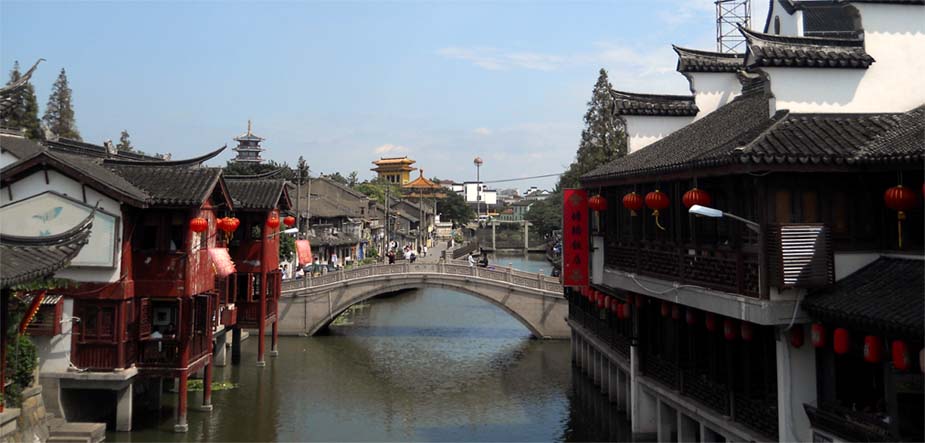
Seven Treasures:
The Allure of the Water Towns
| published September 27, 2015 |
By Michael Bush, Thursday Review contributor
Whether you are only in Shanghai for a few days, visiting family for several months, or have lived in the giant megacity for many years, you will at one point or another be given the recommendation to visit a “water town.” These places are wonderful ways to experience some living history, escape the bustle of the city, and try some food that is hard to find in the alleys and side streets of Shanghai.
Water towns are basically small villages and communities built on a network of canals. These small rivers and waterways wind their way through the towns, with abundant arching bridges connecting pedestrian, bicycle and scooter traffic to either side.
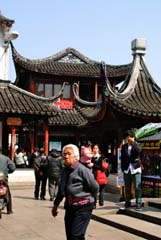 I’ve been to countless water towns in China. Every single one is the same, and yet all are vastly different. Each has it owns charms, special foods, distinct wines, and some even have their own traditional fabric patterns. However, they all have the same things: canals, idyllic bridges, numerous boats to carry you on the canals, a million shops that are fun to look at but are really just tourist traps, and small museums for the most random things imaginable. And, oh, and did I mention the bridges, canals, and boats?
I’ve been to countless water towns in China. Every single one is the same, and yet all are vastly different. Each has it owns charms, special foods, distinct wines, and some even have their own traditional fabric patterns. However, they all have the same things: canals, idyllic bridges, numerous boats to carry you on the canals, a million shops that are fun to look at but are really just tourist traps, and small museums for the most random things imaginable. And, oh, and did I mention the bridges, canals, and boats?
I don’t mean to sound jaded, on the other hand, but once you've seen four or five, just call it a wrap and don’t worry yourself with going to any more water towns. Unless you have family coming to visit and want to show them some they’ve never seen before, or visit a town you have yet to see, the effect wears off after five of these cities along the water. They really are charming the first few times.
Finding one to visit is easy. Eastern China is absolutely overrun with water towns. Why? The Grand Canal, of course. The Grand Canal, or Da Yun He (大运河) is the longest man-made waterway in the world at around 1,100 miles long. Construction began in the 5th century BC and was completed sometime around 618 AD. This great waterway’s purpose was to connect North China to South China, along with everything in between. The leviathan also connects two of China’s greatest rivers, the Yellow River and the Yangtze River. From Beijing to Hangzhou, boats have been continuously riding this artificial river for an eternity.
And where there are waterways, there is trade. Where there is trade, there are stops along the trade route. Enter the water townships of Eastern China. Perhaps in times long past these trade communities were more unique and individual than today, but the Cultural Revolution in China destroyed much of their uniquely beautiful ancient history, and they have largely been replaced in the modern day by whitewashed facsimiles of the originals.
Still, after living in China for so long, you begin to appreciate these representations of ancient history as what they are: a culture struggling to regain what was ripped from their hands against the peoples’ will. To me, this makes these sites interesting and beautiful in ways much different than the historical sites of Europe.
With a legion of water towns to choose from, every expat and local has their own favorites and opinions to give you. “Go Tongli for the sex museum!” “Go to Xitang for the ceiling corridors!” “Go to Luzhi! It has 41 bridges!” And so forth. The war between the water towns is real and in full swing. The one thing that all of these people will probably have in common is that they will tell you not to waste your time in Qibao.
They could not be more wrong.
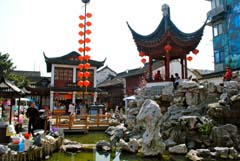 Qibao Town (七宝镇), built during the Northern Song Dynasty (960-1126 AD), is probably the smallest of all the water towns, owing to the fact that it resides within the city limits of Shanghai. It’s actually accessible via the metro on Line 9. To me, that is point one in favor of Qibao—it is easy to get to.
Qibao Town (七宝镇), built during the Northern Song Dynasty (960-1126 AD), is probably the smallest of all the water towns, owing to the fact that it resides within the city limits of Shanghai. It’s actually accessible via the metro on Line 9. To me, that is point one in favor of Qibao—it is easy to get to.
Qibao literally translates to “Seven Treasures” from Mandarin. This is in reference to… wait for it… seven treasures that were once held in the small township. One of these is actually still present in modern day Qibao, referred to in English as the “The Big Bell Floated From Afar.”
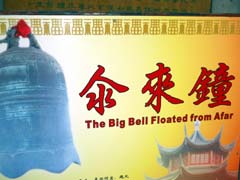
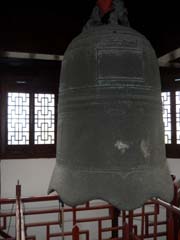
The legend of the bell is that when the local temple was completed, a massive storm struck Qibao and lasted for seven days, swelling the river to overflowing capacity. Once the storm abated, the locals found a giant bell washed ashore. It is said on a sign at the temple, “with great reverence and awe in their mind, the town folks had placed the bell inside the Tutoring Temple.” So, yeah, a magic bell. That’s point number two for old Qibao.
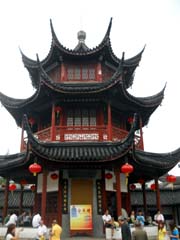
I’d like to get point number three out of the way now, as it’s mainly just for me. I love Qibao because my good friend and former drummer of my punk band XXYY lives there, along with his wife Aurora and their three beautiful children. (Hi guys! Miss you). The personal connection makes it high on my list.
Anyway, once you begin to enter Qibao ancient town you will find about 600 million people in your way. On most days, that is. Domestic tourists flock to Shanghai, and one of the stops on their big bus megatours is almost always Qibao. That might be considered a strike against the place, but it gives a certain ambience that I find charming. Annoying as all get out, but charming too, unless you have a thing about crowds. Point number four!
But once you fight your way through the army of tourists, you will find one of the few bridges in this water town. It’s small, it’s quaint, and I love it. It links the two pedestrian streets on either side of the river. That’s right, only two pedestrian streets in this water town so you won’t get lost. It’s impossible. If you do, leave Asia and never return. Point number five!
A local delicacy in China, found in multiple regions is a horror known as chou doufu (臭豆腐). It smells like gym socks and tastes like it too. Known in English as stinky tofu, it is a very simple concept.
Step 1. Take some tofu and let it ferment / go rotten.
Step 2. Fry it. Scare away the foreigners with its pungent stench.
Step 3. Profit?
Seriously though, most locals love it and can’t understand why we don’t. I’ve eaten it several times over the years, and it does get better each time. Which is like saying it hurts less every time you punch the tree in order to harden your knuckles.
Qibao ancient town is famous for its long and fascinating food street. Incredible sights can be found here. Pig trotters sold in several different styles, all delicious. An amazing xiaolongbao (小笼包), or soup dumpling, stall that is to die for. Literally, you might die being crushed by the locals rushing to stampede you in order to get theirs first.
But the number one thing I heard before going to Qibao was that their stinky tofu was the mildest in all of Shanghai. Go to this one stall by the canal, and you’ll actually be able to stand it. So I did.
It wasn’t bad. It just tasted like the garlic chili sauce and black vinegar had been spread on a dirty gym sock. Yum! When friends and family came to visit me, I always took them to this stall to have stinky tofu. It’s a must try for visiting China, so you might as well get the mildest stink you can. Point six for Qibao!
There are more things to do and see in this town. A cool sword shop that makes the young warrior in you come out swinging. A little coffee shop where you can buy and write postcards while sipping your Americano, and then they will mail the cards for you! Points seven and eight!
A shadow puppet theater, a museum of miniatures, a 9D theater (I don’t know if it’s actually 9D but it seems that all of these places are always adding a digit to outdo the competition), and tons more. So for anyone to say that Qibao is lacking in things to do is a travesty. For shame, people that say such things, for shame. Points nine through… I don’t know, let’s just say fifteen.
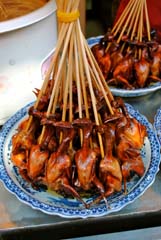
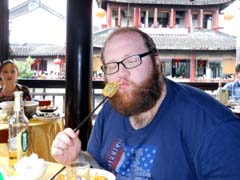
If you walk all the way down the food street in Qibao, you’ll come across some also admittedly vile things. Baby birds roasted on a stick, with said stick poking through their eyeless sockets… never going to make me hungry. But the worst…by far…is the black bottoms.
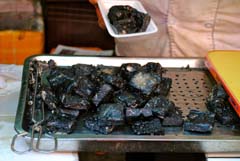 What are black bottoms? Why, they are the reason we have to roll back our points by one... nay, by four. It’s a version of stinky tofu that has rotted so much as to go black. Yes, it’s black with mold and decay. Then fried and eaten. The horror, the horror. Minus four points, Qibao! Back to eleven.
What are black bottoms? Why, they are the reason we have to roll back our points by one... nay, by four. It’s a version of stinky tofu that has rotted so much as to go black. Yes, it’s black with mold and decay. Then fried and eaten. The horror, the horror. Minus four points, Qibao! Back to eleven.
There are plenty of small restaurants found on the pedestrian streets, as well as in some of the nooks and crannies shooting off from the main paths. I found one such place during my first experience in the ancient water town of Qibao. We grew tired, hungry, and ready for beer after a good bit of walking around sightseeing. We came upon a farmer’s style restaurant right on the water. It was beautiful and smelled magnificent.
The dishes brought to us were plentiful and tasted better than most things I’ve ever eaten. The Chinese have a way of making simple ingredients explode with complicated and layered flavors. Of these marvelous dishes, one was referred to as Farmer’s Bucket Chicken. How do you pass that up? I ordered it, and began to serve myself some from the bucket once it arrived. I placed the chicken pieces on my place, adding rice, ladling some sauce over it. I was salivating. Then I noticed the head of the chicken cut in half vertically, through the beak, skull, and all. An eye for each side, too.
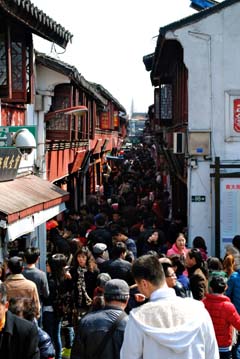 I could have given Qibao a hundred extra points for such an amazing memory, but lets be honest, that was not the first or last time I saw an animal head on my plate in China.
I could have given Qibao a hundred extra points for such an amazing memory, but lets be honest, that was not the first or last time I saw an animal head on my plate in China.
As I walked out of Qibao for the first time, planning this article in my head four years in advance, I thought of all the other water towns I’d heard about but not yet visited, and felt sure that they could never compare to how awesome Qibao truly was. I was completely wrong of course.
Qibao is great, but it’s got the same stuff as all the others. It’s just closer, and I’m pretty lazy.
Related Thursday Review articles:
The Long Corridor: How One American Adjusts to Life in China; Michael Bush; Thursday Review; September 19, 2015.
China Devalues Its Currency; Thursday Review staff; Thursday Review; August 12, 2015.
